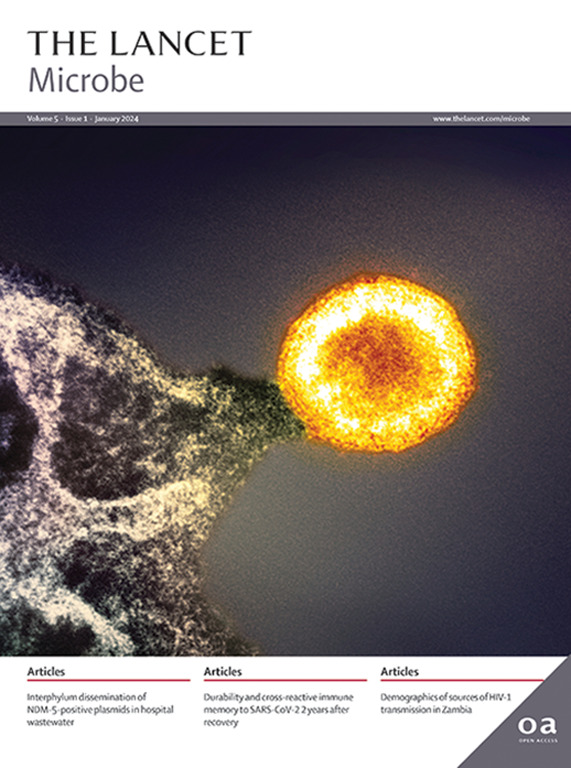有或没有人巨细胞病毒垂直传播给胎儿的孕前免疫孕妇的免疫学概况:一项回顾性观察研究。
IF 20.4
1区 生物学
Q1 INFECTIOUS DISEASES
引用次数: 0
摘要
背景:人巨细胞病毒(CMV)垂直传播给胎儿(先天性巨细胞病毒感染)可发生在孕前免疫的孕妇中。与先天性巨细胞病毒感染相关的母体免疫学特征研究甚少。我们的目的是描述孕前免疫孕妇在有或没有人类巨细胞病毒垂直传播给胎儿的情况下的免疫学特征。方法:在这项回顾性队列研究中,我们纳入了2017年9月1日至2020年10月15日期间在伦巴第(儿童)先天性人巨细胞病毒感染研究(意大利)中有(先天性巨细胞病毒组)和没有(非先天性巨细胞病毒组)宫内人巨细胞病毒传播的孕妇(年龄0 - 18岁)。在妊娠13周和分娩时采集血液。测量并比较各组之间的以下免疫参数:血清中和效价、抗体依赖细胞的细胞毒性、人cmv特异性长期记忆T细胞(白细胞介素[IL]-7R+和IL-2+)和效应记忆CD45RA+ (TEMRA)细胞。我们还比较了在意大利帕维亚基金会(Fondazione IRCCS Policlinico San Matteo)注册的两组人巨细胞病毒原发感染孕妇的免疫参数:原发感染1组抗体应答(随访12个月,入组时间为2011年2月23日至2015年9月1日)和原发感染2组t细胞应答(随访24个月,入组时间为2016年7月10日至2020年3月18日)。研究结果:128名女性纳入本研究:56名女性来自CHILd研究(16名女性为先天性巨细胞病毒组,40名女性为非先天性巨细胞病毒组),72名孕妇为原发性感染(原发性感染1组40名[15名,25名无垂直传播],原发性感染2组32名[11名,21名无垂直传播])。与非先天性CMV组相比,先天性CMV组的中和活性更高(p≤0.022),但抗体依赖性细胞毒性更低(p= 0.04)。此外,先天性CMV组的长期记忆T细胞百分比低于非先天性CMV组(p≤0.022)。先天性巨细胞病毒组和非先天性巨细胞病毒组的TEMRA细胞无显著差异。先天性巨细胞病毒组在感染后12-24个月内的免疫学参数与原发性感染1组和2组相似。解释:宫内人巨细胞病毒传播的免疫妇女具有不同的免疫参数(不同于没有巨细胞病毒传播的免疫妇女,但与原发性感染的妇女相似),可能是那些在母体免疫发育完成前几年内发生原发性人巨细胞病毒感染的妇女。一种能够引起母体对人类巨细胞病毒完全免疫的疫苗可能对胎儿有保护作用。资助:巴西地区生物医学基金会和墨西哥致敬部。本文章由计算机程序翻译,如有差异,请以英文原文为准。
Immunological profile of pregnant women with preconception immunity with or without vertical transmission of human cytomegalovirus to the fetus: a retrospective observational study
Background
Vertical transmission of human cytomegalovirus (CMV) to the fetus (congenital CMV infection) can occur in pregnant women with preconception immunity. Maternal immunological features associated with congenital CMV infection have been poorly investigated. We aimed to characterise the immunological features of pregnant women with preconception immunity in cases with and without vertical transmission of human CMV to the fetus.
Methods
In this retrospective cohort study, we included pregnant women (aged >18 years) with preconception immunity enrolled between Sept 1, 2017, and Oct 15, 2020, in the Congenital Human Cytomegalovirus Infection in Lombardy (CHILd) study (Italy) with (congenital CMV group) and without (no-congenital CMV group) intrauterine human CMV transmission. Blood was collected at 13 weeks of gestation and at delivery. The following immune parameters were measured and compared between groups: serum neutralising titres, antibody-dependent cell cytotoxicity, human CMV-specific long-term memory T cells (interleukin [IL]-7R+ and IL-2+), and effector memory CD45RA+ (TEMRA) cells. Immune parameters were also compared with those of two groups of pregnant women with human CMV primary infection enrolled at Fondazione IRCCS Policlinico San Matteo (Pavia, Italy) in two previous studies: primary infection group 1 for antibody response (followed up for 12 months; enrolled between Feb 23, 2011, and Sept 1, 2015,) and primary infection group 2 for T-cell response (followed up for 24 months; enrolled between July 10, 2016, and March 18, 2020).
Findings
128 women were included in this study: 56 women from the CHILd study (16 women in the congenital CMV group and 40 women in the no-congenital CMV group) and 72 pregnant women with primary infection (40 in primary infection group 1 [15 with and 25 without vertical transmission] and 32 in primary infection group 2 [11 with and 21 without vertical transmission]). Higher neutralising activity (p≤0·022) but lower antibody-dependent cell cytotoxicity (p=0·0004) was observed in the congenital CMV group versus the no-congenital CMV group. Additionally, the congenital CMV group had a lower percentage of long-term memory T cells than the no-congenital CMV group (p≤0·022). No significant difference was found for TEMRA cells between congenital CMV and no-congenital CMV groups. Immunological parameters of the congenital CMV group were similar to those observed in primary infection groups 1 and 2 within 12–24 months after infection.
Interpretation
Immune women with intrauterine human CMV transmission have distinct immunological parameters (different from immune women without CMV transmission, but similar to women with primary infection) and might be those who had a primary human CMV infection within a few years earlier before maternal immunity development was completed. A vaccine able to elicit a fully developed maternal immunity to human CMV is likely to be protective for the fetus.
Funding
Fondazione Regionale per la Ricerca Biomedica, and Ministero della Salute.
求助全文
通过发布文献求助,成功后即可免费获取论文全文。
去求助
来源期刊

Lancet Microbe
Multiple-
CiteScore
27.20
自引率
0.80%
发文量
278
审稿时长
6 weeks
期刊介绍:
The Lancet Microbe is a gold open access journal committed to publishing content relevant to clinical microbiologists worldwide, with a focus on studies that advance clinical understanding, challenge the status quo, and advocate change in health policy.
 求助内容:
求助内容: 应助结果提醒方式:
应助结果提醒方式:


